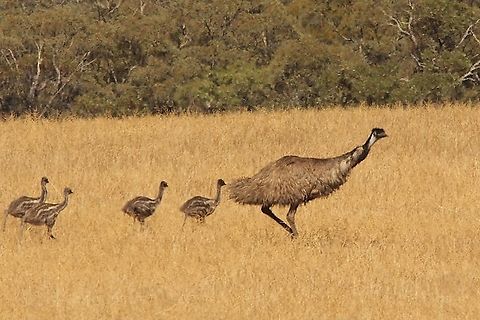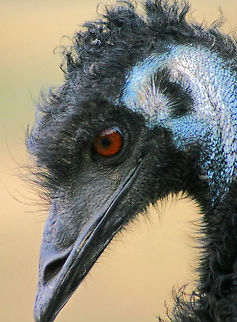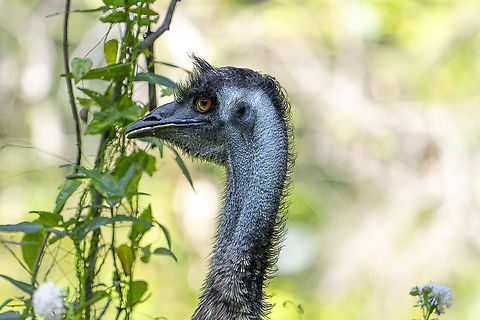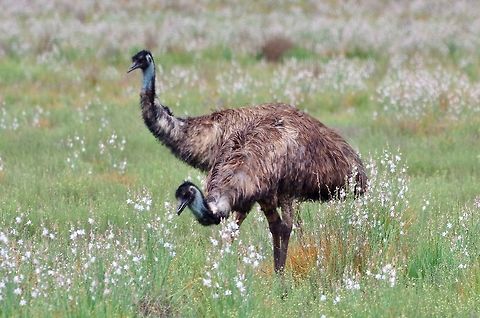
Appearance
Emus are large birds. The largest can reach up to 1.5–1.9 m in height, 1–1.3 m at the shoulder. In length measured from the bill to the tail, emus range from 139 to 164 cm, with males averaging 148.5 cm and females averaging 156.8 cm. Emus weigh between 18 and 60 kg, with an average of 31.5 kg and 36.9 kg in males and females, respectively. Females are usually larger than males by a small amount, and are substantially wider across the rump.They have small vestigial wings, the wing chord measuring around 20 cm long, and have a small claw at the tip of the wing. The bill is quite small, measuring 5.6 to 6.7 cm. The emu flaps its wings when it is running and it is believed that they stabilise the bird when it is moving. It has a long neck and legs. Their ability to run at high speeds, 48 km/h, is due to their highly specialised pelvic limb musculature. Their feet have only three toes and a similarly reduced number of bones and associated foot muscles; they are the only birds with gastrocnemius muscles in the back of the lower legs. The pelvic limb muscles of emus have a similar contribution to total body mass as the flight muscles of flying birds....hieroglyph snipped... When walking, the emu takes strides at every 100 cm, but at full gallop, a stride can be as long as 275 cm. Its legs are devoid of feathers and underneath its feet are thick, cushioned pads. Like the cassowary, the emu has sharp claws on its toes which are its major defensive attribute. This is used in combat to inflict wounds on opponents by kicking. The toe and claw are a total of 15 centimetres. They have a soft bill, adapted for grazing.
The emu has good eyesight and hearing, which allows it to detect nearby threats. Its legs are among the strongest of any animals, powerful enough to tear down metal wire fences.
The neck of the emu is pale blue and shows through its sparse feathers. They have brown to grey-brown plumage of shaggy appearance; the shafts and the tips of the feathers are black. Solar radiation is absorbed by the tips, and the loose-packed inner plumage insulates the skin. The resultant heat is prevented from flowing to the skin by the insulation provided by the coat, allowing the bird to be active during the heat of the day. A unique feature of the emu feather is its double rachis emerging from a single shaft. Both of the rachis have the same length, and the texture is variable; the near the quill it is rather furry, but the external ends resemble grass. The sexes are similar in appearance, although the male's penis can become visible when it defecates. The plumage varies in colour due to environmental factors, giving the bird a natural camouflage. Feathers of emus in more arid area with red soil have a similarly tinted plumage but are darker in animals residing in damp conditions.
The eyes of an emu are protected by nictitating membranes. These are translucent, secondary eyelids that move from the end of the eye closest to the beak to cover the other side. This is used by the emu as a protective visor to protect its eyes from dust that is prevalent in windy and arid deserts. The emu also has a tracheal pouch, which becomes more prominent during the mating season. It is often used during courting, and it has speculated that it is used for communication on a day-to-day basis. The pouch is more than 30 centimetres, is spacious and the wall in very thin. Its opening's width is only 8 centimetres. The quantity of air that goes through the pouch, as determined by the emu deciding to open or close it, affects the pitch of an emu's call. Females typically cry more loudly than males.
On very hot days, emus pant to maintain their body temperature, their lungs work as evaporative coolers and, unlike some other species, the resulting low levels of carbon dioxide in the blood do not appear to cause alkalosis. For normal breathing in cooler weather, they have large, multifolded nasal passages. Cool air warms as it passes through into the lungs, extracting heat from the nasal region. On exhalation, the emu's cold nasal turbinates condense moisture back out of the air and absorb it for reuse. As with other ratites, the emu has great homeothermic ability, and can maintain this status from −5 to 45 degrees. The thermoneutral zone of emus lies between 10–15 degrees and 30 degrees.
As with other ratites, the emu has a relatively low rate of metabolism compared to other types of birds, but the rate depends on activity, especially due to resulting changes to thermodynamics. At −5 degrees, the metabolism rate of an emu while sitting down is around 60% of the value for one that is standing, as the lack of feathers under its stomach leads to a higher rate of heat loss when it is standing up and exposing the underbelly.
Their calls consist of loud booming, drumming, and grunting sounds that can be heard up to 2 kilometres away. The booming sound is created in an inflatable neck sac that is 30 cm long and thin-walled. The different sounds produced can be used to distinguish males and females. The loud booming caused by inflation of the cervical sac corresponds to females, while loud grunts are limited to male emus.

Status
Emus were used as a source of food by indigenous Australians and early European settlers. Aboriginal Australians used a variety of techniques to catch the bird, including spearing them while they drank at waterholes, poisoning waterholes, catching emus in nets, and attracting them by imitating their calls or with a ball of feathers and rags dangled from a tree. The indigenous Australians used pituri or other poisonous plants to contaminate water supplies and were easily able to catch disoriented emus that drank the water. They also sometimes disguised themselves using the skins of emus they had previously killed. Emus were also lured into capture in camouflaged pits using rags or imitation calls. Aboriginal Australians did not kill the animals except to eat them, and frowned on peers who hunted the emus but then left the meat unused. They also used almost every part of the carcass for some purpose. Aside from the meat, the fat was harvested for oil used for polishing their weapons, and the bones and tendon were used as makeshift knives and tools, and for tying, respectively.Europeans killed emus to provide food and to remove them if they interfered with farming or invaded settlements in search of water during drought. An extreme example of this was the Emu War in Western Australia in 1932, when emus that flocked to Campion during a hot summer scared the town’s inhabitants and an unsuccessful attempt to drive them off was mounted, with the army called in to dispatch them in the so-called 'war'. There were two phases, the second of which started on 12 November with mixed results. There have been two documented cases of humans being attacked by emus.
The early white settlers also used emu fat for fuelling lamps. In the 1930s, emu killings in Western Australia peaked at 57,000 per year, and culls were also plentiful in Queensland at the same time due to rampant crop damage. Even in the 1960s, bounties were still paid in Western Australia for killing emus. In John Gould's "Handbook to the Birds of Australia", first published in 1865, he laments the loss of the emu from Tasmania, where it had become rare and has since become extinct; he notes that emus were no longer common in the vicinity of Sydney and proposes that the species be given protected status. Wild emus are formally protected in Australia under the "Environment Protection and Biodiversity Conservation Act 1999", though the IUCN rates their status as Least Concern. Their occurrence range is between 4,240,000–6,730,000 km2, and a 1992 population estimate was between 630,000 and 725,000.
Although the population of emus on mainland Australia is thought to be higher now than before European settlement, some wild populations are at risk of local extinction due to small population size. Threats to small populations include the clearance and fragmentation of areas of habitat; deliberate slaughter; collisions with vehicles; and predation of the young and eggs by foxes, feral and domestic dogs, and feral pigs. The isolated emu population of the New South Wales North Coast Bioregion and Port Stephens is listed as endangered by the New South Wales Government.

Habitat
Emus live in most habitats across Australia, although they are most common in areas of sclerophyll forest and savanna woodland, and least common in populated and very arid areas, except during wet periods. Emus predominately travel in pairs, and while they can form enormous flocks, this is an atypical social behaviour that arises from the common need to move towards food sources. Emus have been shown to travel long distances to reach abundant feeding areas. In Western Australia, emu movements follow a distinct seasonal pattern – north in summer and south in winter. On the east coast their wanderings do not appear to follow a pattern. Emus are also able to swim when necessary, although they rarely do so unless the area is flooded or they need to cross a river.They are also known to be inquisitive animals, and are known to approach humans if they see movement of a limb or a piece of clothing. They may follow and observe humans in the wild. Sometimes they poke other animals and then run away after drawing a reaction, as though they are playing a game. An emu spends much of its time preening its plumage with its beak.
Emus sleep during the night, and begin to settle down at sunset, although it does not sleep continuously throughout the night. It can awake and arise up to eight times per night in order to feed or defecate. Before going into a deep sleep, the emu squats on its tarsus and begins to enter a drowsy state. However, it is alert enough to react to visual or aural stimuli and return to an awakened state. During this time, the neck descends closer to the body and the eyelids begin to lower. If there are no aural or visual disturbances, it will go into a deep form of sleep after 20 minutes. During this time the body is lowered until it is touching the ground and its legs are folded. The feathers direct any rain downwards along the mound-like body into the ground, and it has been surmised that the sleeping position is a type of camouflage meant to mimic a small hill. The neck is brought down very low and the beak turned down so that the whole neck becomes S-shaped and folding onto itself. An emu will typically awake from the deep sleep once every 90 to 120 minutes and stand in a tarsal position to eat or defecate. This lasts for ten to twenty minutes and the cycle is repeated four to six times during most nights. Overall, an emu sleeps for around seven hours every day. Young emus are known to sleep with their neck flat and stretching forward along the ground surface.

Reproduction
Emus form breeding pairs during the summer months of December and January, and may remain together for about five months. During this time they wander around in an area a few miles in diameter. It is believed they guard or find territory during this time. Both males and females increase in weight during this time and the female is slightly heavier at between 45 and 58 kg. This weight is lost during the incubation period, the males losing around 9 kg. Mating occurs in the cooler months of May and June, and the exact timing is determined by the climate, as the birds nest during the coldest part of the year. During the breeding season, males experience hormonal changes, including an increase in luteinizing hormone and testosterone levels, and their testicles double in size.It is the females that court the males, and during the mating season, they become physically more attractive. The female's plumage darkens slightly and the small patches of bare, hairless skin just below the eyes and near the beaks turn turquoise-blue, although this is a subtle change. The female strides around confidently, often circling the male, and pulls its neck back while puffing out her feathers and crying out a low, monosyllabic sound that has been compared to human drums. This calling can occur when the males are not in view and more than 50 metres away and when the male's attention has been gained, the female can circle in a radius of 10–40 m. As the female circles its prospective mate, it continues to look towards him by turning its neck, while keeping its rump facing him. During this time, the female's cervical air sac may remain inflated as it calls out. The passive male retains the same colour hair, although the bare patches of skin also turn a light blue. The female has more black hairs on its head but gender differentiation can be difficult for humans. If the male shows interest in the parading female, he will move closer; the female continues to tantalise its target by shuffling further away and continuing to circle him as before.
Females are more aggressive than males during the courting period, often fighting one another for access to mates. Fights among females accounted for more than half of the violent incidents in one mating season study. If a female tried to woo a male that already had a partner, the incumbent female will try and repel the competitor by walking towards her challenger and staring in a stern way. If the male showed interest in the second female by erecting his feathers and swaying from side to side, the incumbent female will attack the challenger, usually resulting in a backdown by the new female. Some female-female competitions can last up to five hours, especially when the target male is single and neither female has the advantage of incumbency. In these cases, the animals typically intensify their mating calls and displays, which increase in extravagance. This is often accompanied by chasing and kicking by the competing females.
Males lose their appetite and construct a rough nest in a semi-sheltered hollow on the ground from bark, grass, sticks, and leaves. The nest is almost always a flat surface rather than a segment of a sphere, although in cold conditions the nest is taller, up to 7 cm tall, and more spherical to provide more insulation. When other material is lacking, it can also use spinifex grass bushes more than a metre across, despite the prickly nature. The nest can be placed in open ground or near scrubs and rocks, although thick grass is usually present if the emu takes the former option. The nests are usually placed in an area where the emu has a clear view of the surrounds and can detect predators.
If a male is interested, he will stretch his neck and erect his feathers and bend over and peck at the ground. He will then sidle up to the female, swaying his body and neck from side to side, and rubbing his breast against his partner's rump, usually without calling out. The female would accept by sitting down and raising her rump.
The pair mates every day or two, and every second or third day the female lays one of an average of 11 very large, thick-shelled, dark-green eggs. The shell is around 1 mm thick although indigenous Australians say that northern eggs are thinner. The number of eggs varies with rainfall. The eggs are on average 134 by 89 millimetres and weigh between 700 and 900 grams, which is roughly equivalent to 10–12 chicken eggs in volume and weight. The first verified occurrence of genetically identical avian twins was demonstrated in the emu. The egg surface is granulated and pale green. During the incubation period, the egg turns dark green, although if the egg never hatches, it will turn white from the bleaching effect of the sun.
The male becomes broody after his mate starts laying, and begins to incubate the eggs before the laying period is complete. From this time on, he does not eat, drink, or defecate, and stands only to turn the eggs, which he does about 10 times a day. Sometimes he will walk away at night; he chooses such a time as most predators of emu eggs are not nocturnal. Over eight weeks of incubation, he will lose a third of his weight and will survive only on stored body-fat and on any morning dew that he can reach from the nest. As with many other Australian birds, such as the Superb Fairy-wren, infidelity is the norm for emus, despite the initial pair-bond: once the male starts brooding, the female mates with other males and may lay in multiple clutches; thus, as many as half the chicks in a brood may be fathered by others, or by neither parent as emus also exhibit brood parasitism. Some females stay and defend the nest until the chicks start hatching, but most leave the nesting area completely to nest again; in a good season, a female emu may nest three times. If the parents stay together during the incubation period, they will take turns standing guard over the eggs while the other drinks and feeds within earshot. If it perceives a threat during this period, it will lie down on top of the nest and try to blend in with the similar-looking surrounds, and suddenly stand up and confront and scare the other party if it comes close.
Incubation takes 56 days, and the male stops incubating the eggs shortly before they hatch. The male also increases the temperature of the nest during the eight-week period. Although the eggs are laid sequentially with days of separation, they tend to hatch within two days within one another, as the eggs that were laid later were subject to higher temperatures and developed more quickly. During the process, the precocial emu chicks need to develop a capacity for thermoregulation. During incubation, the embryos are ectothermic but need to develop endothermic behaviour by the time it is hatched.
Newly hatched chicks are active and can leave the nest within a few days. They stand about 12 centimetres tall, weigh.5 kg, and have distinctive brown and cream stripes for camouflage, which fade after three months or so. The male stays with the growing chicks for up to 7 months, defending them and teaching them how to find food. Chicks grow very quickly and are full-grown in 5–6 months; they may remain with their family group for another six months or so before they split up to breed in their second season. During their early life, the young emus are defended by their father, who adopts a belligerent and standoffish stance towards other emus, even including the mother. The father does so by ruffling his feathers, emitting sharp grunts, and kicking his legs to shoo off other animals. He can also bend his knees to shield his smaller children. At night, he envelops his young with his feathers. As the young emus cannot travel far, the parents must choose an area with plentiful food in which to breed. In the wild, emus live between 10 to 20 years; captive birds can live longer than those in the wild.

Food
Emus forage in a diurnal pattern. They eat a variety of native and introduced plant species; the type of plants eaten depends on seasonal availability. They also eat insects, including grasshoppers and crickets, lady birds, soldier and saltbush caterpillars, Bogong and cotton-boll moth larvae and ants. This forms a large part of its protein requirements and intake. In Western Australia, food preferences have been observed in travelling emus: they eat seeds from "Acacia aneura" until it rains, after which they eat fresh grass shoots and caterpillars; in winter they feed on the leaves and pods of "Cassia"; in spring, they feed on grasshoppers and the fruit of "Santalum acuminatum": a sort of quandong. They are also known to eat wheat crops, and any fruit or other crops that it can access, easily climbing over high fences if required. Emus serve as an important agent for the dispersal of large viable seeds, which contributes to floral biodiversity. One undesirable effect of this occurred in Queensland in the 1930s and 1940s when emus ate cactus in the outback there. They defecated the seeds in various places as they moved around, spreading the unwanted plant. This led to constant hunting campaigns to stop the cactus from being spread.Emus also require pebbles and stones to assist in the digestion of the plant material. Individual stones may weigh 45 g and they may have as much as 745 g in their gizzard at one time. They also eat charcoal, however scientists still have not ascertained why. Captive emus are also known to eat shards of glass, marbles, car keys, jewellery and nuts and bolts.
Emus drink at infrequent intervals, but ingest large amounts when they do so. They typically inspect the water body in groups for a period before kneeling down at the edge of the water and drinking. They are observed to prefer kneeling on solid earth while drinking, rather than in rocks or mud, presumably due to a fear of sinking. They often drink continuously for 10 minutes, unless disturbed by danger, in which case they interrupt themselves to deal with the threat before resuming. Due to the arid environment, they often go one or two days without finding a source of water and drinking. They typically drink once per day or night, but can do so several times daily if supply is abundant. In the wild, they often share water sources with kangaroos, other birds and wild camels and donkeys that were let loose by European settlers. Emus are suspicious of these other species and tend to wait in bushes and wait for other types of animals to leave; they choose to drink separately to the other animals. If an emu senses abnormal circumstances or a threat, it drinks while standing.
References:
Some text fragments are auto parsed from Wikipedia.